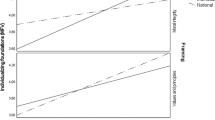Abstract
Recently, a growing number of studies has shown the relevance of Moral Identity to explain (im)moral conduct. The present study compared two moral identity measures in two independent samples (N = 282 and 245): i.e., the Moral Identity Scale (Aquino and Reed, Journal of Personality and Social Psychology 83:1423–1440, 2002) and the Moral Identity Questionnaire (Black and Reynolds, Personality and Individual Differences 97:120–129, 2016). The results revealed that the two scales are rather modestly correlated, which raises the question of whether they are measuring the same construct. Overall, hierarchical regression analyses revealed that the Moral Identity Questionnaire subscales were the superior predictors of (self-reported) moral behavior. Accordingly, this study suggests the use of the Moral Identity Questionnaire over the use of the Moral Identity Scale for the prediction of (im)moral behavior. Future research, however, should also include behavioral measures of (im)moral behavior rather than relying on self-reported behavior only.
Similar content being viewed by others
Data Availability
Data and material supporting this study’s findings are openly available in OSF at https://osf.io/7j2as/?view_only=b3cd43d9c2564738a9768db59b503537.
Notes
Note that this effect is smaller than the smallest observed significant effect (i.e., ΔR2 = 0.488, observed when adding the MIQ to the regression model predicting dire prosocial behaviors). Thus, we concluded that our study was sufficiently powered.
Given that correlation analyses as well as hierarchical regressions showed the superiority of the MIQ over the MIS in predicting (im)moral behavior, we wanted to ensure that these effects were not due to criterion contamination. In particular, the items of the MIQ may probe into the same concepts as some of the behavioral measures, particularly the Prosocial Tendencies measure. For this reason, we excluded all items of the MIQ that were formulated as behavior (MIQ items 1, 5, 6, 8, 11, 13, 14, 15, 17, 18 and 19) and performed the same analyses again. The results show that almost the same effects emerge even after excluding the corresponding items. The effects found are slightly smaller. However, for each of the behavioral outcomes, the MIQ subscales showed stronger correlations than the MIS subscales in both studies, and with respect to the hierarchical regressions, the magnitude of explained variance is higher in 13 of 16 cases when the MIQ is placed in the first block or added in the second block. From this, we conclude that criterion contamination plays a minor role in this context. Tables concerning the above results are available on request from the first author.
References
Aquino, K., & Reed, A., 2nd. (2002). The self-importance of moral identity. Journal of Personality and Social Psychology, 83(6), 1423-1440. https://doi.org/10.1037//0022-3514.83.6.1423
Bennett, R. J., & Robinson, S. L. (2000). Development of a measure of workplace deviance. The Journal of Applied Psychology, 85(3), 349–360. https://doi.org/10.1037/0021-9010.85.3.349
Black, J. E., & Reynolds, W. M. (2016). Development, reliability, and validity of the Moral Identity Questionnaire. Personality and Individual Differences, 97, 120–129. https://doi.org/10.1016/j.paid.2016.03.041
Blasi, A. (1980). Bridging moral cognition and moral action - a critical review of the literature. Psychological Bulletin, 88(1), 1–45. https://doi.org/10.1037/0033-2909.88.1.1
Carlo, G., Hausmann, A., Christiansen, S., & Randall, B. A. (2003). Sociocognitive and behavioral correlates of a measure of prosocial tendencies for adolescents. Journal of Early Adolescence, 23(1), 107–134. https://doi.org/10.1177/0272431602239132
Constandt, B., De Waegeneer, E., & Willem, A. (2018). Coach ethical leadership in soccer clubs: An analysis of its influence on ethical behavior. Journal of Sport Management, 32(3), 185–198. https://doi.org/10.1123/jsm.2017-0182
Ellemers, N., van der Toorn, J., Paunov, Y., & van Leeuwen, T. (2019). The psychology of morality: A review and analysis of empirical studies published from 1940 through 2017. Personality and Social Psychology Review, 23(4), 332–366. https://doi.org/10.1177/1088868318811759
Faul, F., Erdfelder, E., Buchner, A., & Lang, A.-G. (2009). Statistical power analyses using G*Power 3.1: Tests for correlation and regression analyses. Behavior Research Methods, 41(4), 1149–1160. https://doi.org/10.3758/BRM.41.4.1149
Haesevoets, T., Van Hiel, A., & Folmer, C. R. (2021). Does game behavior extend beyond the lab? The ecological validity of mixed-motive games and the impact of personality [Manuscript in preparation]. Department of Developmental, Personality and Social Psychology, Ghent University, Belgium.
Hertz, S. G., & Krettenauer, T. (2016). Does moral identity effectively predict moral behavior?: A meta-analysis. Review of General Psychology, 20(2), 129–140. https://doi.org/10.1037/gpr0000062
Jennings, P. L., Mitchell, M. S., & Hannah, S. T. (2015). The moral self: A review and integration of the literature. J. Organiz. Behav., 36, S104–S168. https://doi.org/10.1002/job.1919
Kenny, D. A., Kaniskan, B., & McCoach, D. B. (2015). The performance of RMSEA in models with small degrees of freedom. Sociological Methods & Research, 44(3), 486–507. https://doi.org/10.1177/0049124114543236
Moorman, R. H., & Blakely, G. L. (1995). Individualism-collectivism as an individual difference predictor of organizational citizenship behavior. Journal of Organizational Behavior, 16(2), 127–142. https://doi.org/10.1002/job.4030160204
Schwitzgebel, E., & Rust, J. (2014). The moral behavior of ethics professors: Relationships among self-reported behavior, expressed normative attitude, and directly observed behavior. Philosophical Psychology, 27(3), 293–327. https://doi.org/10.1080/09515089.2012.727135
Funding
This work was supported by the Research Foundation – Flanders (FWO) [grant number: S005521N].
Author information
Authors and Affiliations
Corresponding author
Ethics declarations
Conflicts of Interest
No potential competing interest was reported by the authors.
Ethics Approval
Both studies were approved by the ethical commission of the Faculty of Psychology and Educational Sciences at Ghent University (file number: 2021/13).
Consent to Participate
Participants were asked for their informed consent before participation.
Consent for Publication
Participants were asked for their informed consent to use the collected data for scientific publications before participation.
Additional information
Publisher's Note
Springer Nature remains neutral with regard to jurisdictional claims in published maps and institutional affiliations.
Appendix A
Appendix A
Table 3
Rights and permissions
About this article
Cite this article
Tissot, T.T., Van Hiel, A., Haerens, L. et al. The Moral Identity Questionnaire predicts prosocial behavior better than the Moral Identity Scale. Curr Psychol 42, 22738–22744 (2023). https://doi.org/10.1007/s12144-022-03361-y
Accepted:
Published:
Issue Date:
DOI: https://doi.org/10.1007/s12144-022-03361-y




